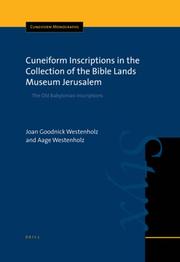| Listing 1 - 2 of 2 |
Sort by
|

ISBN: 9789004147102 9004147101 9786611396794 1281396796 9047408381 Year: 2006 Volume: 33
Abstract | Keywords | Export | Availability | Bookmark
 Loading...
Loading...Choose an application
- Reference Manager
- EndNote
- RefWorks (Direct export to RefWorks)
This volume offers new cuneiform sources on the political, religious, juridical, and economic history of southern Babylonia in the nineteenth and early eighteenth centuries B.C.E. Among these texts is a 600-lines long document (no. 1) recording in unusual detail the daily routine followed in the temples of the city of Larsa and thus sheds light on the religious practices of the ancient Babylonians. Using this document as its point of departure, the first part of the book examines those practices - the service of the gods and the performance of the clergy. This document is especially important for the history of ancient religion.
Akkadian language --- Cuneiform inscriptions, Akkadian. --- Babylonia --- History --- Religion. --- Cuneiform inscriptions [Akkadian ] --- Inscriptions cunéiformes akkadiennes --- Opschriften in spijkerschrift [Akkadische ] --- Cuneiform inscriptions, Akkadian --- Akkadian cuneiform inscriptions --- Vavilonii︠a︡ --- Bavel --- Bābil --- Babylonien --- Sumer --- Texts --- Sources --- Religion

ISBN: 9056930397 9789056930394 9789004494909 9004494901 Year: 2000 Volume: 20 I
Abstract | Keywords | Export | Availability | Bookmark
 Loading...
Loading...Choose an application
- Reference Manager
- EndNote
- RefWorks (Direct export to RefWorks)
The archive of the Egibi family from the 6th century BC originates in Babylon and covers a time span of more than 100 years and five generations. It is known as the largest and most important private archive from the Neo-Babylonian period. Although nearly 800 tablets were already published in cuneiform copies by the end of the 19th century, no comprehensive text edition and study of this archive has been completed so far. This book presents the first step and focuses on the purchase of land (date orchards and arable land) by the Egibi family. About 240 records (property titles and related debt notes, receipts, field plans, etc.) form the core of the archive and are closely interrelated with other aspects of the family's business. Nearly half of them were previously unpublished. The book provides transliterations ans translations of all texts, as well as copies of new material including hitherto unknown sealings of published tablets. The study shows how the Egibi family managed to accumulate considerable wealth in real estate over a relatively short period of time. The impact of inheritance and marriages and the way the estates were damaged are also examined.
Akkadian language --- Cuneiform inscriptions. --- Family archives --- Kleitabletten. --- Spijkerschrift. --- Geschiedbronnen. --- Grondbezit. --- Overeenkomsten. --- Babylonië --- Babylonië. --- Clay tablets --- cuneiform --- History Resources --- Land ownership --- Similarities --- Agrarian tenure --- Feudal tenure --- Freehold --- Land question --- Landownership --- Tenure of land --- Land use, Rural --- Real property --- Land, Nationalization of --- Landowners --- Serfdom --- Archives --- Family records
| Listing 1 - 2 of 2 |
Sort by
|

 Search
Search Feedback
Feedback About UniCat
About UniCat  Help
Help News
News